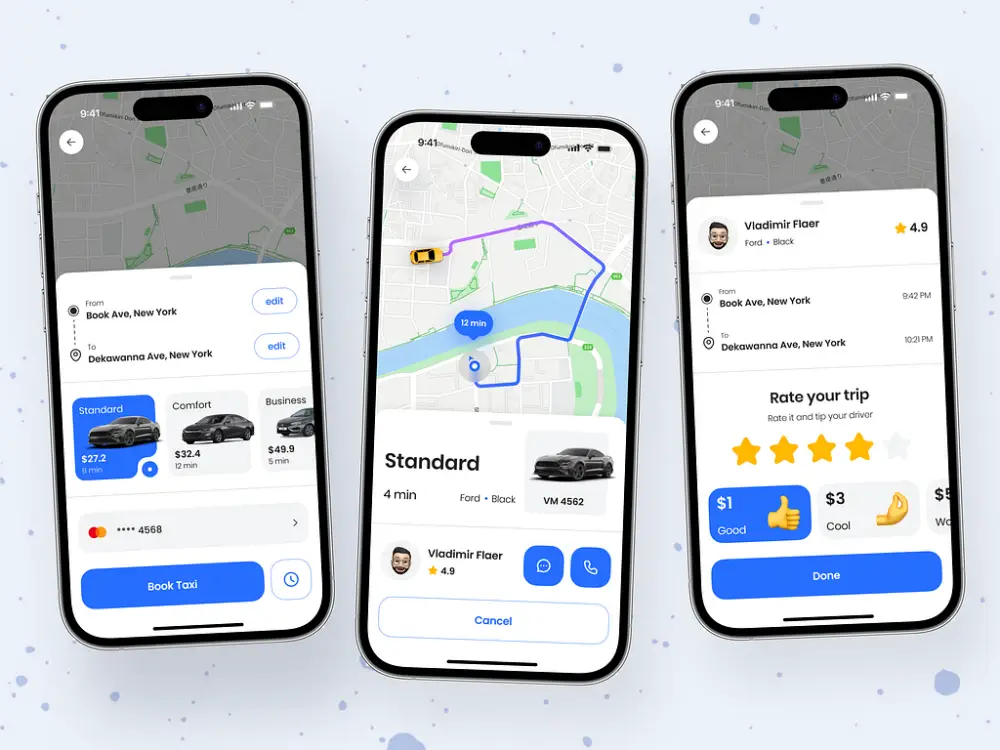How to Master Taxi Mobile App Development in 2025
- TECHVIFY Team
- 0 Comments
Technology has changed how food delivery and transportation services work. Online taxi booking services are now common, and we all know about instant taxi mobile applications like Uber, Grab, and Ola.
The global taxi booking app market is expected to grow at a 4.2% CAGR and reach $283 billion by 2028. About 1,747.13 million people are expected to use ride-hailing services daily in 2024. The taxi booking business is a huge opportunity.
In this article, we will cover everything you need to know about taxi mobile app development. Here is a detailed breakdown.
I. Understanding Taxi Mobile Application Development
A taxi booking app is a digital platform allowing users to book and pay for rides from drivers who use their cars or those provided by a taxi company. These apps can be built for Android, iOS, or both.
The main function of a taxi booking app is to connect passengers with nearby drivers quickly. Users can track the driver’s location and arrival time in real time. They can also see estimated trip fares and times before booking. The app lets users choose vehicle types and set specific ride preferences.
These apps, often called ride-sharing or ride-hailing services, offer a modern alternative to traditional taxi services. They eliminate the need to flag down a taxi on the street or call a dispatch center for a ride.
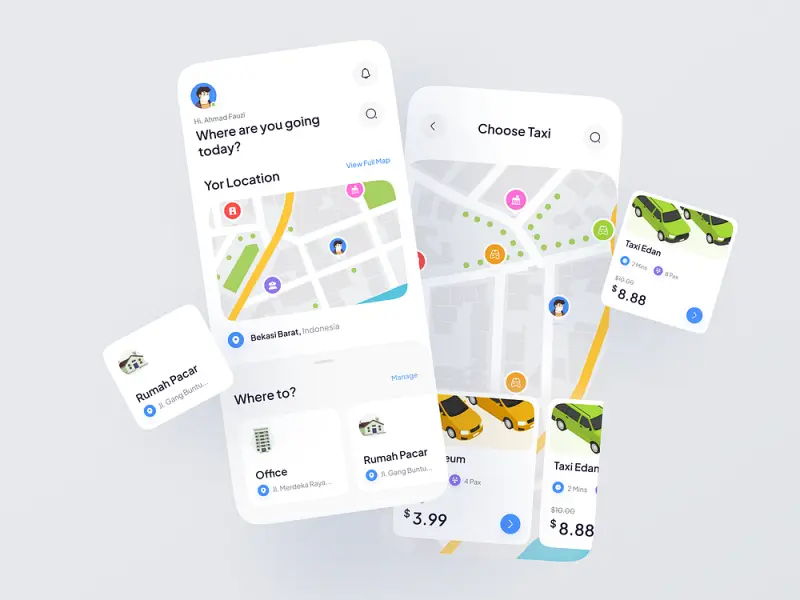
II. Key Features of a Dedicated Taxi Booking App
A taxi booking app consists of three main components: the rider app, the driver app, and the admin panel. Each has its features to make the service efficient for everyone involved. The complexity of these features affects the cost and time required to develop the app.
App owners must decide whether to create a minimum viable product (MVP) or a fully developed taxi mobile application. An MVP includes only the essential features needed for basic operation, while a complete version offers more advanced functionalities.
For Passengers:
- User Registration/Login: Allows users to sign up or log in using their email, phone number, or social media accounts. The process is designed to be quick and easy to encourage more users.
- Ride Booking: The core feature that connects users with the nearest drivers. Passengers enter their pick-up and drop-off locations, choose the vehicle type, and add any special requests for the driver.
- Live GPS Location Tracking: This feature lets passengers track their rides in real-time. GPS helps calculate fares based on distance and time traveled.
- Payment Gateways: These offer multiple payment options, such as credit/debit cards, digital wallets, or cash. This feature also supports automatic payments at the start or end of each trip.
- Rating & Review System: Customers can provide feedback on their trips, including service quality, vehicle condition, and driver behavior. This feature helps improve the service by holding drivers accountable.
- Push Notifications: Keeps users informed about trip details, ride status updates, promotions, and other important information.
- Help & Support: This service allows passengers to contact support agents during or after a trip. Passengers can send messages or call for assistance.
For Drivers
- Registration/Login: Drivers need to register and log in to activate their profiles. This process requires personal information, driver’s license details, vehicle information, and background checks.
- Accept/Reject Ride Requests: Drivers can accept or decline ride requests based on details such as pickup location, destination, and availability.
- Navigation System: An in-app navigation feature helps drivers find the most efficient routes to pick-up and drop-off locations.
- Earnings Dashboard: Drivers can view reports and track their daily, weekly, or monthly earnings. The dashboard includes trip details, booking history, tips, and bonuses.
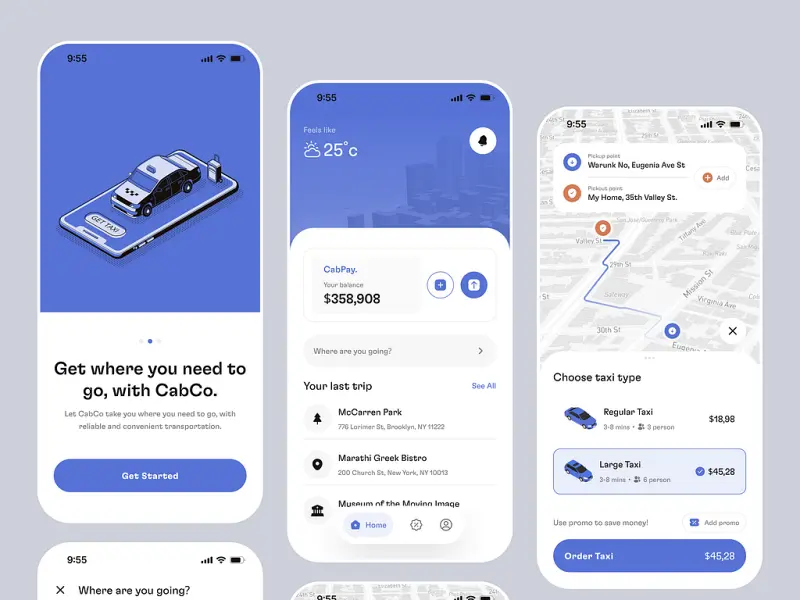
For Admins:
- Dashboard/Admin Panel: This central control allows admins to monitor real-time activities, analyze data from both drivers and customers and manage the overall app performance.
- Driver Management & User Management: Admins can approve, add, remove, disqualify, or suspend drivers based on performance data such as ratings, reviews, and ride histories. Similar functions apply to passenger user management.
- Trip/Ride Management: Admins can track trip requests, cancellations, and refunds. They can monitor the status of each ride (ongoing, completed, or canceled) and take over a driver’s account in emergencies to resolve issues or disputes.
- Fare & Payment Management: Admins manage payment gateways, fare calculations, discounts, and coupon codes. They can set the revenue model and adjust fare rates based on vehicle type, time of day, demand (surge pricing), and special promotions.
- Geofencing & Zone Management: Admins can create geofenced areas for specific purposes, such as defining zones with different pricing or restricting services to certain areas.
III. Benefits of On-Demand Taxi Booking Apps
Developing an on-demand taxi booking app can significantly improve your business and boost your ROI. Here are some key benefits:
- Increase Your Brand Awareness
An on-demand taxi booking app can enhance your online presence and recognize your business, thus increasing your brand awareness. For example, Uber reported 130 million users in Q1 of 2023, a 7.7% increase from Q1 of 2022. Reliable service can further enhance your brand’s growth. - Riders’ Data Accumulation
Access customer data such as trip type, fee paid, destination, and cab type. Use this data to personalize services and improve customer experiences. Tailored experiences increase loyalty and retention, leaving customers satisfied. - Effective Management
An admin panel allows business owners to manage customers and drivers on the same platform, making routine operations easier. - Direct Earnings
A taxi app eliminates middlemen who charge commissions, boosting your profit margin and improving conversion rates. - Customer Feedback
The review and ratings section helps you understand what impresses your target audience and what needs improvement. In-app feedback improves user satisfaction, making them repeat customers. A 2024 report states that nearly half of consumers place as much trust in online reviews as they do in personal recommendations. - Fare Calculation
The app handles fare calculation, freeing your business from this task. - Driver Performance Monitoring
Monitoring driver performance is crucial for your taxi booking business. Poor driver behavior can negatively impact your app’s reputation.
Have a Project Idea in Mind?
Get in touch with experts for a free consultation. We’ll help you decide on next steps, explain how the development process is organized, and provide you with a free project estimate.
IV. A Detailed Guide to Taxi App Development
Finally, we arrive at the most crucial part: the development phase. This stage is crucial to the success of your project, so it’s essential to execute it correctly.
Step 1: Have A Key App Concept
Your basic concept should provide taxi services and better job opportunities for drivers. Think about how you can uniquely attract and satisfy users. For instance, Uber focuses on passenger needs by offering convenient pick-ups and drop-offs. Your idea should stand out and be well-promoted.
Step 2: Competent Analysis
Carry out an in-depth analysis of the market, target audience, and competitors. This analysis should provide real data about market trends, user preferences, and competitors’ strengths and weaknesses. Use this information to refine your app concept and ensure it meets user needs.
Step 3: Financing the Project
If you lack the budget, look for investors. Consider crowdfunding campaigns or venture capital funds interested in your startup idea. The taxi mobile application development cost is high, so plan your budget carefully. Look for detailed budgeting information to guide your financial planning.
Step 4: List out Main Features
Once you have a great market data-driven concept and the funds to bring it to life, it’s time to list the features that will turn your idea into a functional mobile app for taxi services. Start with core features and expand functionality later.
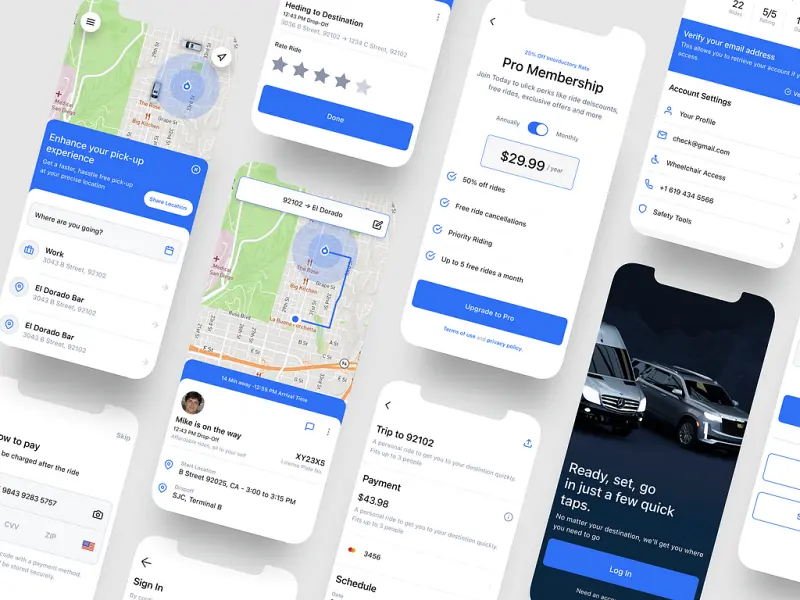
Step 5: Hiring a Team of Experts
Choosing the right taxi app development company is crucial. Start by examining their portfolio for similar projects to ensure they understand your industry. A diverse and high-quality portfolio indicates flexibility and capability. Detailed case studies showing successful outcomes can provide additional confidence.
Next, consider their experience. A longer track record often means more expertise. Check for specialization in mobile app development, especially in ride-sharing apps. Ensure the team has the necessary skills, including UI/UX design, front-end and back-end development, and quality assurance. Certifications from tech giants like Google or Apple can be a mark of quality.
Review their development approach. Understand their methodology, whether Agile or Waterfall and ensure they maintain transparency and use modern, scalable technologies.
Effective communication is essential. Evaluate their responsiveness and clarity during initial contact. They should commit to regular updates and be open to feedback. Ensure their communication tools and working style align with your expectations.
Step 6: UI/UX Design
Creating an intuitive UI is essential for providing a positive UX. This design stage determines how your app will look and how easy it will be to use.
Step 7: Development Process
This complex and long-term stage significantly influences the taxi app development cost. Choosing the right technology stack is crucial.
Example Technology Stack:
- Backend: Node.js, Python, Ruby on Rails
- Frontend: React Native, Flutter
- Database: MongoDB, PostgreSQL
- Payment Integration: Stripe, PayPal
- Maps and Navigation: Google Maps API, Mapbox
Step 8: Testing and Launch the Application
Testing ensures your app works smoothly. A QA team should rigorously test the app before its launch. Publishing your app on the App Store and Google Play can be difficult. Ensure you follow all submission guidelines and requirements.
Step 9: Promotion
Start planning your promotion strategy early to make your taxi booking app profitable. Define your target audiences and tailor your marketing messages to each group. Launch segmented advertising campaigns on social media, search engines, and in-app platforms, highlighting specific benefits for drivers, passengers, and administrators.
Optimize your app store presence with relevant keywords, high-quality visuals, and positive reviews. Engage users through regular social media posts, influencer partnerships, and a blog with appropriate articles. Issue press releases, seek media coverage, and partner with local businesses and events to enhance visibility.
Implement referral programs with incentives and run promotional offers to encourage usage. Finally, use analytics to track performance and adjust your strategy based on user feedback.
Step 10: Product Improvement
Enhance your app regularly based on user feedback and behavior analysis. Regular updates will help meet user needs and keep your app competitive.
Pro Tip: Save money by starting with an MVP (Minimum Viable Product). Launch with essential features and add more as your app gains popularity and profitability. An MVP also helps gather early user feedback for improvements.
Ready to Develop Your Taxi Booking App?
Contact TECHVIFY’s experts for a free consultation. We’ll guide you through the development process, answer your questions, and provide a free project estimate.
V. Examples of the Most Popular Taxi Apps
Several well-known names dominate the cab booking platforms in the global taxi market. Learning from industry leaders can provide valuable insights if you’re considering a good taxi mobile app development idea.
1. Grab
Since 2012, Grab is a Singapore-based tech company offering ride-hailing, food delivery, and package delivery services throughout Southeast Asia. Grab provides various services within one mega platform: Motorbike taxis (GrabBike), private cars (GrabCar), premium vehicles (GrabPremium), and more.
Grab also has its e-wallet, GrabPay, which enables customers to make payments for services within the app. Grab competes fiercely with other global players in the taxi industry with a simplified user interface and strong customer support. It is expanding its services beyond transportation into e-commerce and other sectors.
2. Uber
Universally recognized as a pioneer in ride-hailing services, Uber was founded in 2009 by an America-based app development company. Uber’s services are available in more than 900 metropolitan areas worldwide.
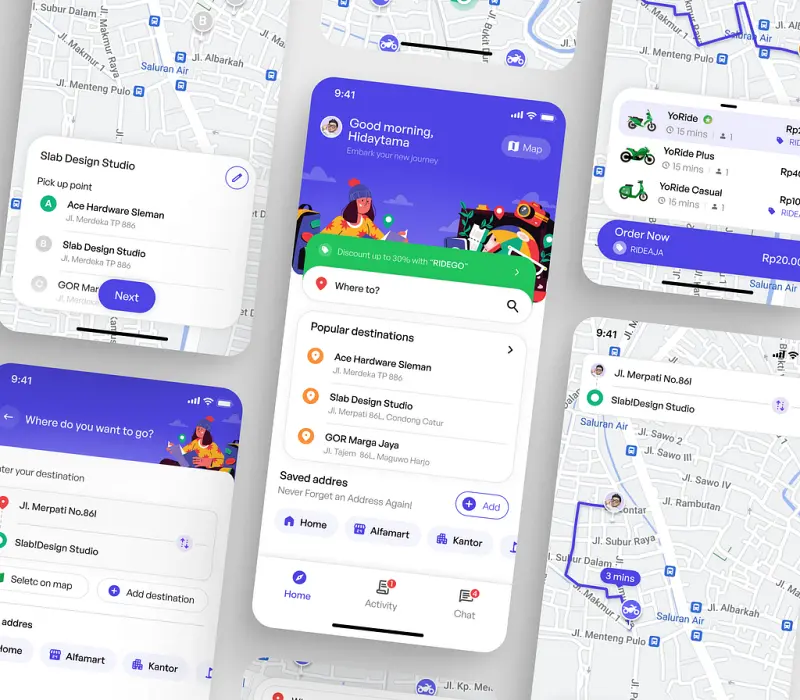
This “super app” offers a variety of ride options, including economy, premium, accessible vehicles, carpooling, and bike-sharing, all within a single platform. Regarding taxi mobile app development, many developers and organizations view Uber as a role model for their products.
3. Ola Cabs
Founded in December 2010, Ola Cabs is a prominent ride-hailing service headquartered in Bangalore, India, with services extending to over 250 cities in nations such as New Zealand, Australia, and the United Kingdom.
Ola Cabs offers various ride options, including economy, business class, premium, and shared rides. The “Ola Share” feature allows passengers to share rides with others heading in the same direction at a lower price. Ola also provides food delivery services (Ola Foods) and e-wallet options for payment (Ola Money).
3. DiDi
Launched in 2012, DiDi is a Chinese taxi booking app with over 550 million users and an average of around 30 million daily rides. DiDi offers bike-sharing and carpooling options, and users can rent vehicles for periods at their disposal.
The platform supports multiple payment modes (cash, credit card, or DiDi’s e-wallet system) and various languages, catering to a diverse user base.
4. Lyft
Known as Uber’s direct competitor, Lyft was established in 2012. Its primary markets are the United States and Canada. Lyft offers standard ride options, luxury cars, scooters, and bike-sharing services.
Additionally, Lyft provides a feature called “Round Up & Donate,” allowing users to round up fares to the nearest dollar and donate the difference to a charity they choose. Lyft has a good reputation for emphasizing local community engagement and driver welfare.
VI. Challenges in the Taxi Application Development Process
When starting a mobile taxi app development project, you must be prepared to face potential pitfalls. The task is risky and challenging, but the rewards can be high if executed correctly.
Dealing with System Loads
At some point, your app will need to handle large amounts of data. As your app becomes more popular, this data will increase. If your system can’t manage the load, the app may slow down, work incorrectly, or even crash.
This leads to user dissatisfaction. Dissatisfied users are less loyal, making it harder to monetize them.
Therefore, your taxi app must be able to handle peak loads. Here are some tips:
- Powerful Server: Ensure you have a powerful server.
- Market Analysis: Determine the maximum workload your project might face. For example, a small town’s workload is different from that of an entire country.
- Data Storage: Plan where and what kind of information you will store to avoid overloading the server.
- Technology Stack: Choose the right technology stack for development.
- Testing: Test the system thoroughly before launching to ensure it can handle the loads.
This might sound complex, but that’s why taxi booking app development can be expensive.
Location Tracking Correctness
One key problem for taxi mobile application is the inaccuracy in determining the user’s or vehicle’s location. This can lead to situations where the driver cannot find the passenger, resulting in frustration for both parties.
The Consequences:
- Driver and Passenger Frustration: Incorrect location data can cause delays and misunderstandings.
- Decreased Reliability: Users may lose trust in the app’s accuracy and reliability.
To avoid these issues, accurate and frequent location updates are crucial. For instance, Uber connects to the server every few seconds to provide the most accurate location data. If you plan to create a taxi booking app clone, consider implementing a similar strategy. Here are some tips:
- Frequent Location Updates: Ensure your app updates location data every few seconds to maintain accuracy.
- Use High-Precision Location Services: Leverage advanced GPS and location services to improve accuracy.
- Optimize Algorithms: Implement algorithms to correct minor location inaccuracies and predict the user’s or vehicle’s movement.
- User Feedback Mechanism: Allow users to correct their location if it’s significantly off manually.
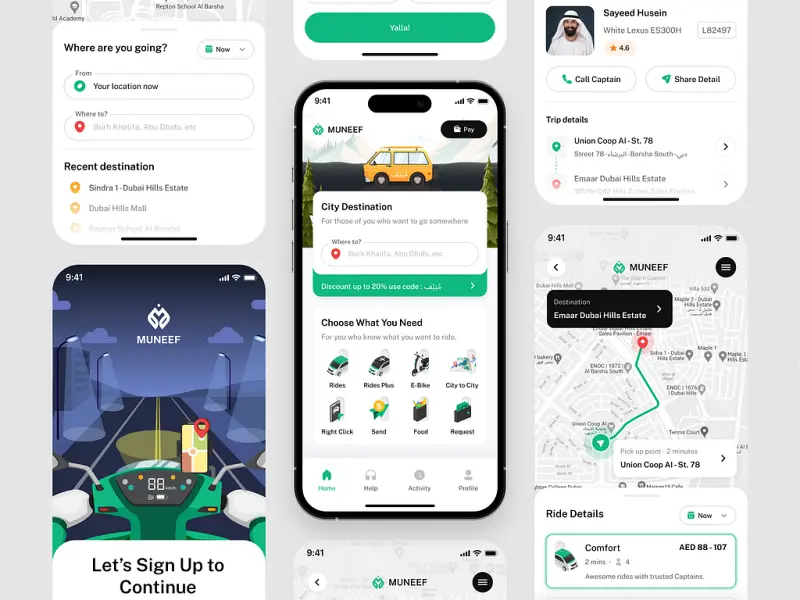
Application Scalability
At first, your app may handle a small number of orders, but over time, it could grow significantly (since you’re aiming to create the best cab booking app on the market, right?).
Therefore, you need to ensure your project is scalable from the beginning. One good approach is to divide the program architecture into several key components, such as:
- Location Services: Handle storage, processing, and management of location information.
- Real-Time Systems: Deal with constantly updated data, such as vehicle tracking and notifications.
- Business Logic: Manage payments and other workflows.
Advantages of This Approach:
- Modular Architecture: Each component can be scaled independently for more efficient resource management.
- Fault Isolation: If one part of the system crashes, it won’t bring down the entire application, minimizing data loss and downtime.
Payment Processing
Your taxi booking solution will surely allow users to pay online. Such a feature is crucial today; without it, competing with other players in the market is impossible. Ensuring secure, efficient payment processing is essential, but it comes with its own set of challenges.
Key Considerations:
- Choosing the Right Payment System: Many payment systems are available, and selecting the right one for your app is critical. Look for systems that offer robust security features and are widely trusted by users.
- Securing User Data: Protecting users’ payment information is paramount. Never store credit card information locally, and ensure that all data is encrypted and complies with relevant security standards, such as PCI DSS (Payment Card Industry Data Security Standard).
By partnering with reliable payment processors and implementing best practices for data security, you can provide a seamless and secure payment experience for your users.
Processing Unplanned Stops
In your imagination, you draw the perfect picture: a user opens your online taxi booking application, finds a car, and gets to the specified destination in the time your service has predicted. However, in reality, things may be different.
Challenges:
- Traffic Jams and Rush Hours: Unexpected traffic can delay rides significantly.
- Unplanned Stops: Passengers or drivers may need to make unanticipated stops.
Solutions:
- Real-Time Updates: Implement real-time traffic updates and dynamic route adjustments to provide the most accurate arrival times possible.
- Flexible Pricing Algorithms: Develop algorithms that adjust ride prices based on real-time conditions, such as traffic delays or extended stops.
Addressing these challenges requires sophisticated technology and constant real-time data monitoring to ensure the best possible user experience.
Don’t let these challenges intimidate you. You don’t have to solve these problems on your own. By hiring a professional taxi app development company, you can leverage their expertise to overcome these difficulties.
Speaking of such a team, why not consider TECHVIFY? Our experienced team is ready to help you build a robust and scalable taxi booking app that meets all your requirements.
Conclusion
The taxi booking industry offers a promising opportunity for innovation and growth. Developing a robust, user-friendly app can set you apart in this competitive market. This guide has covered everything you need to bring your taxi mobile app development idea to life, from essential features to development challenges.
However, building a successful app requires expertise. That’s where TECHVIFY comes in.
Ready to make your taxi booking app a game-changer? Let’s transform your vision into the next big thing.
TECHVIFY – Global AI & Software Solutions Company
For MVPs and Market Leaders: TECHVIFY prioritizes results, not just deliverables. Reduce time to market & see ROI early with high-performing Teams & Software Solutions.
- Email: [email protected]
- Phone: (+84)24.77762.666




